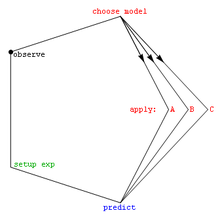- Model selection
-
Model selection is the task of selecting a statistical model from a set of candidate models, given data. In the simplest cases, a pre-existing set of data is considered. However, the task can also involve the design of experiments such that the data collected is well-suited to the problem of model selection.
Contents
Introduction
In its most basic forms, model selection is one of the fundamental tasks of scientific inquiry. Determining the principle that explains a series of observations is often linked directly to a mathematical model predicting those observations. For example, when Galileo performed his inclined plane experiments, he demonstrated that the motion of the balls fitted the parabola predicted by his model.
Of the countless number of possible mechanisms and processes that could have produced the data, how can one even begin to choose the best model? The mathematical approach commonly taken decides among a set of candidate models; this set must be chosen by the researcher. Often simple models such as polynomials are used, at least initially. Burnham and Anderson (2002) emphasize the importance of choosing models based on sound scientific principles, modeling the underlying data throughout their book.
Once the set of candidate models has been chosen, the mathematical analysis allows us to select the best of these models. What is meant by best is controversial. A good model selection technique will balance goodness of fit with simplicity. More complex models will be better able to adapt their shape to fit the data (for example, a fifth-order polynomial can exactly fit six points), but the additional parameters may not represent anything useful. (Perhaps those six points are really just randomly distributed about a straight line.) Goodness of fit is generally determined using a likelihood ratio approach, or an approximation of this, leading to a chi-squared test. The complexity is generally measured by counting the number of parameters in the model.
Model selection techniques can be considered as estimators of some physical quantity, such as the probability of the model producing the given data. The bias and variance are both important measures of the quality of this estimator.
Asymptotic efficiency is also often considered.
A standard example of model selection is that of curve fitting, where, given a set of points and other background knowledge (e.g. points are a result of i.i.d. samples), we must select a curve that describes the function that generated the points.
Methods for choosing the set of candidate models
Experiments for choosing the set of candidate models
- Design of experiments
- Optimal design
- Fractional factorial design (Screening experiments)
Criteria for model selection
- Akaike information criterion
- Bayes factor
- Bayesian information criterion
- Deviance information criterion
- Focused information criterion
- Mallows' Cp
- Minimum description length (Algorithmic information theory)
- Minimum message length (Algorithmic information theory)
- Stepwise regression
- Cross-validation
See also
- False discovery rate
- Freedman's paradox
- Occam's razor
- Optimal design
- Regression model validation
References
- Anderson, D.R. (2008), Model Based Inference in the Life Sciences, Springer.
- Aznar Grasa, A. (1989). Econometric Model Selection: A New Approach, Springer. ISBN 978-0-7923-0321-3
- Burnham, K.P., and Anderson, D.R. (2002). Model Selection and Multimodel Inference: A Practical Information-Theoretic Approach, 2nd ed. Springer-Verlag. ISBN 0-387-95364-7 [This has over 10000 citations on Google Scholar.]
- Chamberlin, T.C. (1890) "The method of multiple working hypotheses", Science 15: 93. (Reprinted 1965, Science 148: 754–759 [1].)
- Claeskens, G., and Hjort, N.L. (2008). Model Selection and Model Averaging, Cambridge University Press.
- Phil C. Gregory (2005) Bayesian logical data analysis for the physical sciences: A comparative approach with Mathematica support (Cambridge U. Press, Cambridge UK) preview.
- Lahiri, P. (2001). Model Selection, Institute of Mathematical Statistics.
- Massart, P. (2007). Concentration Inequalities and Model Selection, Springer.
Least squares and regression analysis Computational statistics Least squares · Linear least squares · Non-linear least squares · Iteratively reweighted least squaresCorrelation and dependence Regression analysis Regression as a
statistical modelSimple linear regression · Ordinary least squares · Generalized least squares · Weighted least squares · General linear modelPredictor structureNon-standardNon-normal errorsDecomposition of variance Model exploration Background Mean and predicted response · Gauss–Markov theorem · Errors and residuals · Goodness of fit · Studentized residual · Minimum mean-square errorDesign of experiments Numerical approximation Applications Regression analysis category - Statistics category · Statistics portal · Statistics outline · Statistics topics Categories:- Model selection
- Statistical models
- Statistical theory
- Regression variable selection
- Design of experiments
Wikimedia Foundation. 2010.

